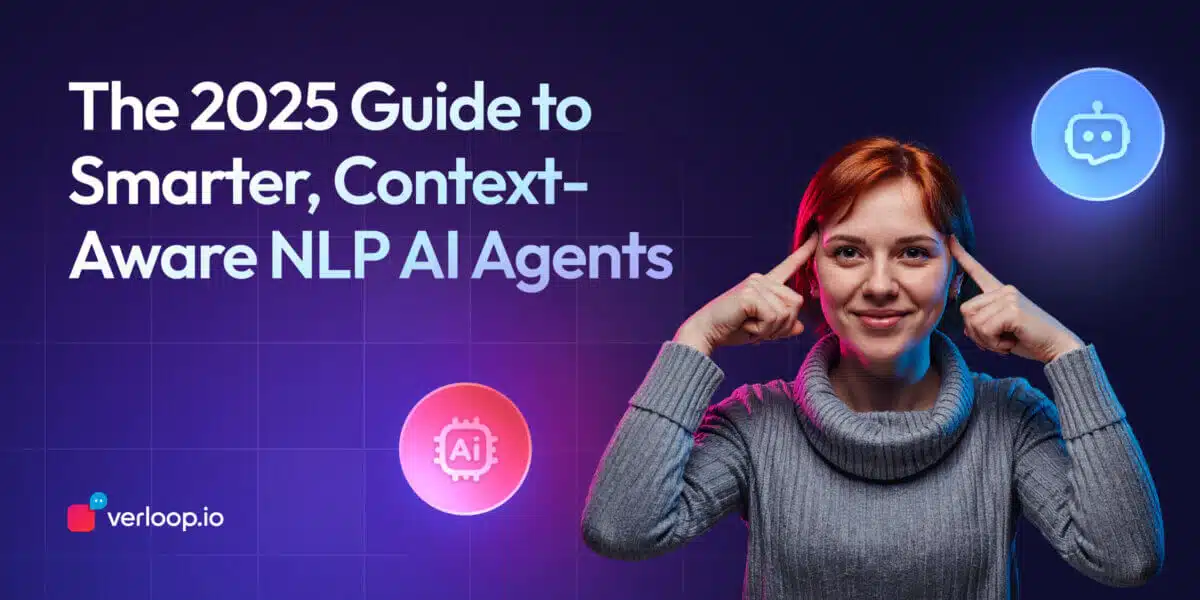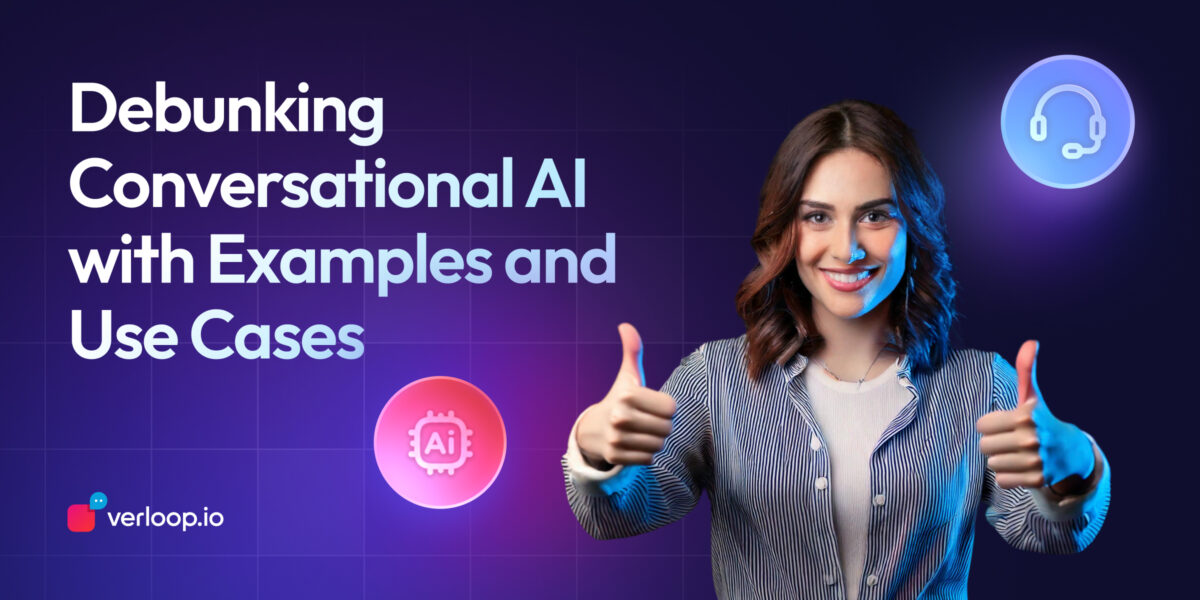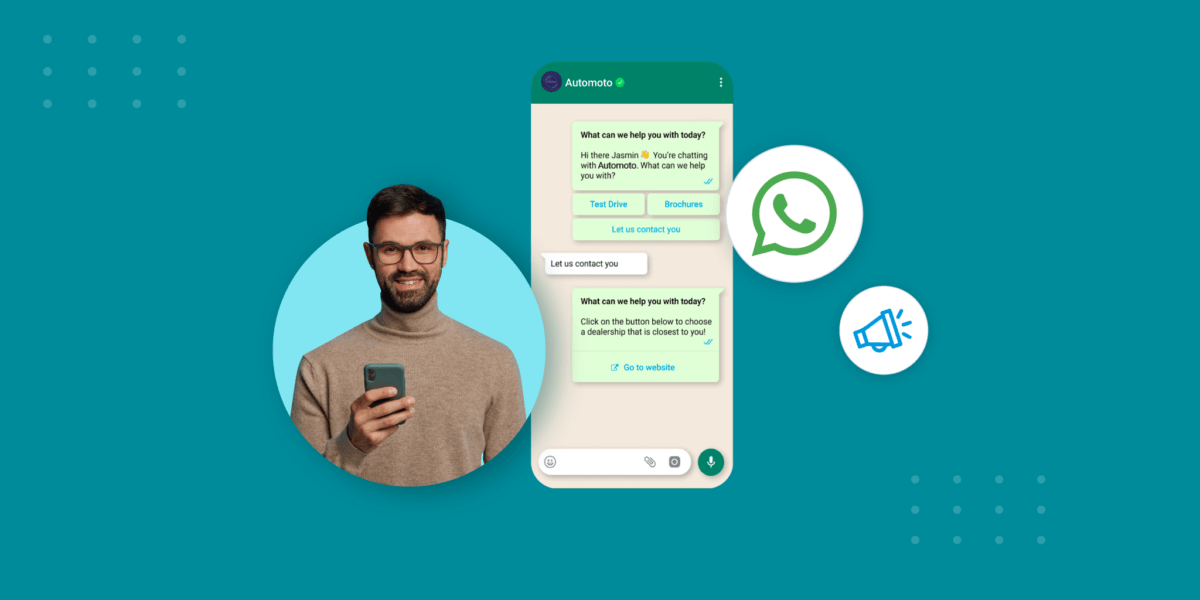NLP Chatbots in 2025: Beyond Conversations, Towards Intelligent Engagement
- April 10th, 2025 / 7 Mins read
- Harshitha Raja

NLP Chatbots in 2025: Beyond Conversations, Towards Intelligent Engagement
- April 10th, 2025 / 7 Mins read
- Harshitha Raja
In 2025, the world of NLP (Natural Language Processing) chatbots has transformed dramatically, moving beyond the limitations of simple talks to come to light as highly developed platforms for intelligent engagement. The days of clunky chatbots are over; today’s NLP chatbots are transforming connections across industries, from targeted marketing campaigns to faster employee onboarding processes.
Consider a virtual assistant taking you throughout a customised shopping journey or aiding with healthcare consultations, dramatically improving productivity and user experience. These situations demonstrate the profound effect of NLP chatbots in altering how people engage with businesses and learn.
As we traverse this paradigm change, it’s critical to rethink the narratives surrounding NLP chatbots. They are no longer just used for customer service; they are becoming essential tools in a variety of industries. Consider the significant ramifications of chatbots with predictive skills, which may identify user requirements before they are even spoken, transforming both consumer interactions and operational efficiency.
What is an NLP Chatbot?
Let’s delve into the essence of Natural Language Processing (NLP). At its core, NLP serves as a pivotal technology facilitating conversational artificial intelligence (AI) to engage with humans using natural language. Its fundamental goal is to comprehend, interpret, and analyse human languages to yield meaningful outcomes. One of its key benefits lies in enabling users to interact with AI systems without necessitating knowledge of programming languages like Python or Java.
The utilisation of NLP in chatbots stems from its foundation in deep learning principles. This empowers machines, specifically chatbots in this context, to decode user inputs and formulate appropriate responses. The NLP engine employs natural language understanding to dissect user queries, discern their intent, and ascertain the actions the user desires the machine to undertake. Subsequently, employing natural language generation (NLG), the machine crafts responses in a language comprehensible to the user.
Latest Updates:
Recent advancements in NLP have seen significant strides in improving its accuracy and efficiency. Enhanced deep learning models and algorithms have enabled NLP-powered chatbots to better understand nuanced language patterns and context, leading to more accurate interpretations of user queries. Moreover, ongoing research in areas such as transformer architectures and contextual embeddings has contributed to further refining NLP capabilities, resulting in more natural and human-like interactions between users and chatbots.
How Does an NLP Chatbot Work?
The functionality of NLP chatbots hinges on intricate processes that dissect user queries, extract intent, and provide appropriate responses. The following steps elucidate the operation of NLP chatbots:
Domain Classification: User inputs are categorised into predefined conversation domains, enabling the chatbot to comprehend the context effectively. For instance, domains like eCommerce or real estate utilise specific vocabulary related to their respective industries.
Intent Recognition: The chatbot identifies the underlying intent behind user queries, enabling it to discern user needs accurately. For example, a request to “check the status of my order” indicates an intent to track an order.
Entity Extraction: NLP algorithms extract relevant information, or entities, from user queries to understand the complete context. For instance, in the query “What is the weather in Bangalore today?” entities include “Bangalore” and “today.”
Role/Context Analysis: To enhance comprehension, the chatbot analyses the roles and context of entities within the conversation, facilitating nuanced responses. For example, distinguishing between “business hours” refers to open or closed timings based on context.
Key Differences Between NLP Chatbot and Rule-Based Chatbot
The rule-based chatbot is one of the modest and primary types of chatbot that communicates with users on some pre-set rules. It matches KW in the user query to one in its database. It follows a set rule and if there’s any deviation from that, it will repeat the same text again and again. However, customers want a more interactive chatbot to engage with a business.
NLP chatbots give users more room for open-ended conversations. These chatbots understand users’ queries based on context, assess them, and respond to users in natural language. With machine learning algorithms, these chatbots learn from the users’ responses and improve their assessment in the future.
According to AI Business, by 2025, 95% of customer interactions will be powered by AI. While both the chatbots operate in quite a similar manner, we list the key differences between the NLP chatbot and the rule-based chatbot below:
Additional Considerations:
- Sentiment Analysis: NLP chatbots can leverage sentiment analysis to gauge user emotions and tailor responses accordingly. This fosters a more natural and empathetic interaction.
- Multilingual Support: NLP advancements allow chatbots to communicate in multiple languages, catering to a wider global audience.
Benefits of Chatbots using NLP
NLP chatbots offer several advantages over traditional rule-based counterparts:
- Natural Conversations: NLP chatbots emulate human-like interactions, enhancing user engagement and comprehension.
- Enhanced Automation: They can handle a wider range of queries, automating complex interactions and reducing dependence on human intervention.
- Contextual Engagement: By retaining context throughout conversations, NLP chatbots provide personalised and efficient support, minimising user frustration.
- Improved User Experience: Swift responses and streamlined interactions result in enhanced user satisfaction and loyalty.
- Time and Cost Efficiency: NLP chatbots expedite query resolution, optimise operational costs, and free human agents for more value-added tasks.
NLP chatbot use cases
NLP chatbots find diverse applications across industries:
- Banking and Insurance: Assisting with balance inquiries, account status checks, and resolving urgent queries efficiently.
- Customer Care: Providing personalised support and resolving inquiries promptly.
- Healthcare: Facilitating patient feedback, maintaining records, and assisting in diagnostics.
- Hospitality and Travel: Offering real-time assistance with bookings, schedules, and travel-related queries.
- Supply Chain and Logistics: Optimising operations through data analysis and insights extraction.
Suggested Reading: Industries Leveraging The Power Of Chatbot Applications To Grow Their Business!
NLP Chatbots: A Win for Customers and Companies
NLP chatbots represent a paradigm shift in customer engagement, offering businesses a powerful tool to enhance communication, automate processes, and drive efficiency. As the market for NLP technologies continues to expand, integrating conversational AI into business operations promises significant returns in terms of customer satisfaction, operational excellence, and competitive advantage. With projected market growth and compelling statistics endorsing their efficacy, NLP chatbots are poised to revolutionise customer interactions and business outcomes in the years to come.
For businesses seeking robust NLP chatbot solutions, Verloop.io stands out as a premier partner, offering seamless integration and intelligently designed bots tailored to meet diverse customer support needs. While chatbots cannot replace human assistance entirely, leveraging NLP technology can augment customer service by fostering natural, human-like interactions, thus strengthening customer relationships and driving business success.
Powering Intelligence with NLP Advancements
Delving into the most recent NLP advancements shows a wealth of options. Chatbots may now provide awareness of context, analysis of emotions, and personalised responses thanks to improved natural language understanding. Dialogue management enables multiple-turn talks and proactive engagement, resulting in more natural interactions. Machine learning and AI integration drive customization, analysis of sentiment, and continuous learning, resulting in speedier resolutions and emotionally smarter encounters.
Going Beyond Customer Service
NLP chatbots go beyond traditional customer service, with applications spanning multiple industries. In the marketing and sales departments, they help with lead generation, personalised suggestions, and conversational commerce. In healthcare, chatbots help with condition evaluation, setting up appointments, and counselling for patients. Educational institutions use them to provide compelling learning experiences, while human resources departments use them to onboard new employees and support career growth. Chatbots are vital tools in a variety of industries, ranging from optimising procedures to improving user experiences.
Suggested Reading: Faster, Smarter, Better — AI is Improving Customer Service
Building Intelligent & Engaging Chatbots
To ensure success, effective NLP chatbots must be developed strategically. The approach is founded on the establishment of defined objectives and an understanding of the target audience. Training chatbots with different datasets improves their capacity for adaptation and proficiency in understanding user inquiries. Highlighting user-friendly design as well as effortless operation leads to increased engagement and happiness. The addition of data analytics allows for continual performance optimisation and modification of the chatbot over time. To maintain trust and regulatory compliance, moral considerations as well as privacy concerns must be actively addressed. Finally, the goal is to cultivate an environment of innovation and continuous optimisation based on user input and data insights, to guarantee that chatbots develop to meet their users’ ever-changing requirements and expectations.
The Future of NLP Chatbots
Moving ahead, promising trends will help determine the foreseeable future of NLP chatbots. Voice AI agents, AR/VR experiences, as well as physical settings will all be seamlessly integrated through multimodal interactions. Hyper-personalisation will combine user data and AI to provide completely personalised experiences. Emotional intelligence will provide chatbot empathy and understanding, transforming human-computer interactions. Integration into the metaverse will bring artificial intelligence and conversational experiences to immersive surroundings, ushering in a new era of participation.
Chatbots’ capabilities will evolve as NLP technology does. These intelligent interaction tools hold the potential to transform the way we communicate with businesses, obtain information, and learn. NLP chatbots have a bright future ahead of them, and they will play an increasingly essential role in defining our digital ecosystem.
Are you ready to tap into the immense potential of NLP chatbots? Request a demo to explore how they can improve your engagement and communication strategy.






